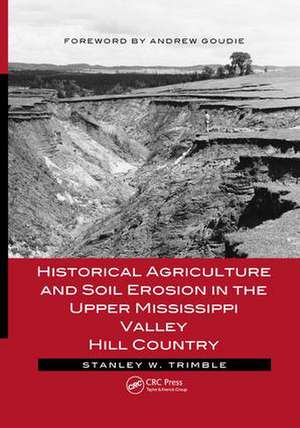Historical Agriculture and Soil Erosion in the Upper Mississippi Valley Hill Country
Autor Stanley W. Trimbleen Limba Engleză Paperback – 23 oct 2017
"Through painstaking field surveys, comparative photographic records, careful dating, a skillful eye for subtle landscape features, and a geographer’s interdisciplinary understanding of landscape processes, the author leads the reader through the arc of an instructive and encouraging story. Farmers—whose unfamiliarity with new environmental conditions led initially to landscape destruction, impoverishment, and instability—eventually adapted their land use and settlement practices and, supported by government institutions, recovered and enriched the same working landscape.
"For the natural scientist, Historical Agriculture and Soil Erosion in the Upper Mississippi Valley Hill Country illustrates how an initially simple alteration of land cover can set off a train of unanticipated changes to runoff, erosion, and sedimentation processes that spread through a landscape over decades—impoverishing downstream landscapes and communities. Distinct zones of the landscape respond differently and in sequence. The effects take a surprisingly long time to spread through a landscape because sediment moves short distances during storms and can persist for decades or centuries in relatively stable forms where it resists further movement because of consolidation, plant reinforcement, and low gradients.
"For the social scientist, the book raises questions of whether and how people can be alerted early to their potential for environmental disturbance, but also for learning and adopting restorative practices. Trimble’s commitment to all aspects of this problem should energize both groups."
—Professor Thomas Dunne, Bren School of Environmental Science and Management, UC Santa Barbara
| Toate formatele și edițiile | Preț | Express |
|---|---|---|
| Paperback (1) | 313.86 lei 6-8 săpt. | |
| CRC Press – 23 oct 2017 | 313.86 lei 6-8 săpt. | |
| Hardback (1) | 685.22 lei 6-8 săpt. | |
| CRC Press – 21 noi 2012 | 685.22 lei 6-8 săpt. |
Preț: 313.86 lei
Preț vechi: 357.35 lei
-12% Nou
Puncte Express: 471
Preț estimativ în valută:
60.06€ • 62.87$ • 49.69£
60.06€ • 62.87$ • 49.69£
Carte tipărită la comandă
Livrare economică 05-19 aprilie
Preluare comenzi: 021 569.72.76
Specificații
ISBN-13: 9781138071612
ISBN-10: 1138071617
Pagini: 290
Ilustrații: 1 Tables, black and white; 212 Illustrations, black and white
Dimensiuni: 178 x 254 x 29 mm
Greutate: 0.52 kg
Ediția:1
Editura: CRC Press
Colecția CRC Press
Locul publicării:Boca Raton, United States
ISBN-10: 1138071617
Pagini: 290
Ilustrații: 1 Tables, black and white; 212 Illustrations, black and white
Dimensiuni: 178 x 254 x 29 mm
Greutate: 0.52 kg
Ediția:1
Editura: CRC Press
Colecția CRC Press
Locul publicării:Boca Raton, United States
Cuprins
The Physical Region and Primeval Landscape. European Settlement and Changes of Land Use. The Systematic Effects of Historical Agriculture on the Physical Landscape. Upland Gully Erosion and its Effects. The Tributaries: Zone of Early, Complex Changes of Process and Form. The Upper Main Valleys: Zone of Later Complex Changes of Process and Form. The Lower Main Valleys: Zone of Perennial Sedimentation. The Great Flood of August 2007 and its Implications. Conclusions. Index.
Notă biografică
Stanley W. Trimble, Professor Emeritus at UCLA, was a research hydrologist with the USGS 1973-1984. He is the author of Man Induced Erosion on the Southern Piedmont (SWCS, 1974, 2008), editor of Encyclopedia of Water Science (CRC, 2008) and co-author (with Andrew Ward) of Environmental Hydrology (CRC, 2004). He was co-editor of Catena, 1996-2006.
Recenzii
"Stanley Trimble’s new book is a welcome addition to the literature on soil conservation in the United States. …This most recent volume represents the culmination of thirty-nine years of research and reflection on human-induced environmental change in a part of the latter region known as the "Driftless Area," a locale so-named for the lack of glacial drift found there. The area encompasses portions of four states—Minnesota, Wisconsin, Iowa, and Illinois—where they adjoin the Mississippi River.… The subject of the book is the dramatic transformation of this landscape wrought by agricultural settlement from the middle of the nineteenth century up to the present."
—Agricultural History, 2015
"... a story of tragedy and triumph. ... The tragedy was the severe damage inadvertently inflicted on the landscape, by well-intentioned settlers doing the best that they could with the tools and knowledge available to them. The triumph has been the landscape’s partial recovery, thanks to the efforts of private citizens and government agencies. The story of the Upper Mississippi River Hill Country is rich in lessons for understanding and managing many other landscapes."
—Jared Diamond, Professor of Geography at UCLA, and Pulitzer-Prize-winning author of Guns, Germs, and Steel, Collapse, and other best-selling books
"[Trimble’s book] is based on almost four decades of dedicated research and has many of the characteristics of a gripping detective story, based on meticulous forensic investigation. … The geomorphologist will learn much from the complexity of stream processes that is evident and from the linkages that occur in different parts of river basins between erosion and deposition ... an exemplification of true Geography ... [a] remarkable work."
—From the Foreword by Andrew Goudie, Professor Emeritus and former Head, School of Geography, University of Oxford
" … intensive, loving field work and reflection. Thanks to clear maps and diagrams, and above all a wealth of well documented photographs, we can all grasp the painful dimension of what in less able hands would be a lifeless tale of mud and dereliction. ... [a] powerful book … and a tribute to dogged, dispassionate enquiry."
—Claudio Vita-Finzi, Natural History Museum, London; Professor of Geology Emeritus, University College London
"Professor Trimble's exceptionally well documented accounts of agricultural landscape disturbance have had a broad impact on the field of geomorphology. In this rich and detailed environmental history of the Upper Mississippi Valley Hill Country, he has broadened the scope to include the human side of the story, describing the social and individual actions that triggered pervasive watershed disturbance with unintended but profound impact on those living and working on the landscape. This is a compelling and delightfully readable narrative ... . Future efforts to sustainably manage this and other agricultural land will require mastery of its combined human and natural history, amply documented and effectively explained, as done so ably in this definitive work."
—Peter R. Wilcock, Professor and Associate Chair, Department of Geography and Environmental Engineering, Johns Hopkins University
"An epoch-defining work on the evolution of landscapes under the influences of changing agricultural practices and on the episodic movement and storage of fluvial sediment. Stan Trimble not only draws deeply on a century and a quarter of previous history, but adds nearly four decades of his own observations (both intensive and extensive) to round out an inspiring chronicle of good science in the service of good stewardship."
—Robert H. Meade, USGS Emeritus
"This is a book of solid science but also the best kind of environmental history describing the interaction of human beings with their landscapes. Trimble brings to this narrative 39 years of field work in this and other regions of the United States and draws on 80 years of data in the process. … A remarkable feature of this definitive study is the ample archival photographs showing, before and after, the decimated landscapes, moonscapes really, and their restoration. These shots, along with Trimble’s generous quotations of journals and other eyewitness accounts, give a depth and granularity to the story which enlivens his narrative. Stanley Trimble also provides a basic introduction, along with a marvelous glossary, which will allow the non-specialist to understand and appreciate the nature of the problem and the ultimate solution pioneered by committed scientists at the USDA and various universities."
––The Environmental Forum, January – February, 2014
—Agricultural History, 2015
"... a story of tragedy and triumph. ... The tragedy was the severe damage inadvertently inflicted on the landscape, by well-intentioned settlers doing the best that they could with the tools and knowledge available to them. The triumph has been the landscape’s partial recovery, thanks to the efforts of private citizens and government agencies. The story of the Upper Mississippi River Hill Country is rich in lessons for understanding and managing many other landscapes."
—Jared Diamond, Professor of Geography at UCLA, and Pulitzer-Prize-winning author of Guns, Germs, and Steel, Collapse, and other best-selling books
"[Trimble’s book] is based on almost four decades of dedicated research and has many of the characteristics of a gripping detective story, based on meticulous forensic investigation. … The geomorphologist will learn much from the complexity of stream processes that is evident and from the linkages that occur in different parts of river basins between erosion and deposition ... an exemplification of true Geography ... [a] remarkable work."
—From the Foreword by Andrew Goudie, Professor Emeritus and former Head, School of Geography, University of Oxford
" … intensive, loving field work and reflection. Thanks to clear maps and diagrams, and above all a wealth of well documented photographs, we can all grasp the painful dimension of what in less able hands would be a lifeless tale of mud and dereliction. ... [a] powerful book … and a tribute to dogged, dispassionate enquiry."
—Claudio Vita-Finzi, Natural History Museum, London; Professor of Geology Emeritus, University College London
"Professor Trimble's exceptionally well documented accounts of agricultural landscape disturbance have had a broad impact on the field of geomorphology. In this rich and detailed environmental history of the Upper Mississippi Valley Hill Country, he has broadened the scope to include the human side of the story, describing the social and individual actions that triggered pervasive watershed disturbance with unintended but profound impact on those living and working on the landscape. This is a compelling and delightfully readable narrative ... . Future efforts to sustainably manage this and other agricultural land will require mastery of its combined human and natural history, amply documented and effectively explained, as done so ably in this definitive work."
—Peter R. Wilcock, Professor and Associate Chair, Department of Geography and Environmental Engineering, Johns Hopkins University
"An epoch-defining work on the evolution of landscapes under the influences of changing agricultural practices and on the episodic movement and storage of fluvial sediment. Stan Trimble not only draws deeply on a century and a quarter of previous history, but adds nearly four decades of his own observations (both intensive and extensive) to round out an inspiring chronicle of good science in the service of good stewardship."
—Robert H. Meade, USGS Emeritus
"This is a book of solid science but also the best kind of environmental history describing the interaction of human beings with their landscapes. Trimble brings to this narrative 39 years of field work in this and other regions of the United States and draws on 80 years of data in the process. … A remarkable feature of this definitive study is the ample archival photographs showing, before and after, the decimated landscapes, moonscapes really, and their restoration. These shots, along with Trimble’s generous quotations of journals and other eyewitness accounts, give a depth and granularity to the story which enlivens his narrative. Stanley Trimble also provides a basic introduction, along with a marvelous glossary, which will allow the non-specialist to understand and appreciate the nature of the problem and the ultimate solution pioneered by committed scientists at the USDA and various universities."
––The Environmental Forum, January – February, 2014
Descriere
Through field surveys, comparative records, a skillful eye for subtle landscape features, and a geographer’s interdisciplinary understanding of landscape processes, this volume uses maps, diagrams, and photographs to illustrate how an initially simple alteration of land cover can set off a train of unanticipated changes to runoff, erosion, and sedimentation processes that spread through a landscape over decades. This story of what occurred in the Upper Mississippi Valley Hill Country raises questions of whether and how people can be alerted early to their potential for environmental disturbance, but also for learning and adopting restorative practices.

















